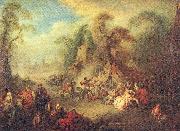Wholesale Oil Painting No Minimum |
|||||||||||
|
|
|||||||||||

|
|||||||||||
|
|
|
||||||||
Pater, Jean-BaptisteFrench Rococo Era Painter, 1695-1736 French painter and draughtsman. He was taught in Valenciennes by Jean-Baptiste Guid? (master 1697; d 1711) and also by his father, Antoine Pater (1670-1747), a sculptor whose portrait was painted by Antoine Watteau (Valenciennes, Mus. B.-A.), who was also a native of Valenciennes. He probably followed Watteau to Paris after the short stay that the latter made in Valenciennes around 1710. Pater thus became a pupil of Watteau. Watteau's difficult character led to Pater's dismissal. He then spent a few hard years on his own in Paris, before returning to Valenciennes around 1715 or 1716. He tried to work independently of the local corporation of St Luc, of which he was not a member; a number of comical legal difficulties ensued, and Pater returned to Paris in 1718. There he must have been in contact with Watteau, since he worked for some of the latter's clients, such as the dealers Pierre Sirois and Edm?-Fran?ois Gersaint, and the collector Jean de Jullienne. In the spring of 1721 the dying Watteau called Pater to him at Nogent, near Paris, apparently full of remorse for his previous attitude and wishing to instruct him in the basic tenets of his painting, |
||||||||
|
|
||||||||
A Country Festival with Soldiers Rejoicing
A Country Festival with Soldiers Rejoicing Painting ID:: 19778 |
1728
Oil on canvas
Mus??e du Louvre, Paris. 1728 Oil on canvas Mus??e du Louvre, Paris. |
|||||||
|
CONTACT US |

